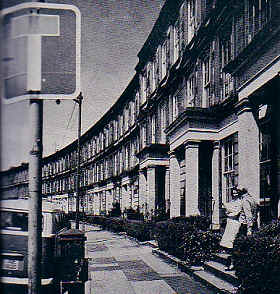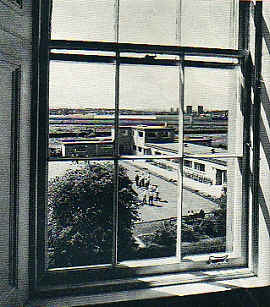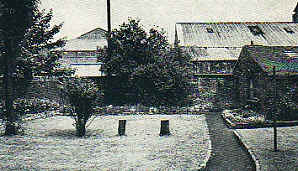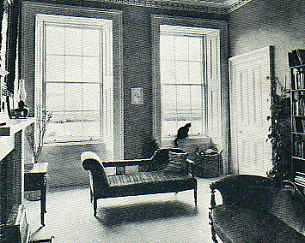|
|
|
This
is taken from a magazine article which first appeared in Scottish
Field, in September 1973. |

Snaking
westwards, St. Vincent Crescent seen from its junction with
Corunna Street |
Catriona
Findlay
GLASGOW
has often been described as the
Victorian city; and certainly the compulsive building in that
period successfully wiped out most of the stone and mortar
evidence of its earlier Georgian prosperity - the latter a time
when it was noted as being "one of the most elegant towns in
Scotland".
Imagine, then, for a moment, that you are suspended above
Glasgow during, let us say, the first half of the 19th century;
suspended above a particular part of it, rather. What do you see?
The River Clyde still sprawling widely as it passes the quaysides
of the town, and meandering along the verges of the green fields
of Stobcross, adjacent to the village of Anderston still, at this
time, outwith the boundary of Glasgow; and from the village an
avenue of old trees leading for about half‑a‑mile to
the gates of Stobcross House which stands by the water. This house
is at the heart of the lands of Stobcross, which originally formed
part of the Bishop's Forest and later of the Great Western
|
|
St Vincent
Crescent and the bowling greens, with the sheds of Queen's Dock
beyond and the fingers of multi-storey
flats south of the river
thrusting
against the horizon |
|

|
Common,
but which at some time, and some how, during the 17th century came
into the possession of the Anderson family who were for three
quarters of a century part of the ruling clique in Glasgow. In 1735 the Anderson family sold the estate to John Orr,
whose nephew 41 years later sold to David Watson, described as a
Merchant in Glasgow. The price was £3000 for 62 acres and the
mansion house.
In
1783 David Watson died, and his children's curators sold Stobcross
for £3750 to yet another "Merchant in Glasgow", John
Phillips, who lived in Stobcross
House until his death in 1829.
Some 15 years later Phillips' trustees sold the estate and
house for £58,246 to a syndicate headed by James Scott; who
with almost 20th century promptitude sold off 20 acres to the
Clyde Trust for about the same price as they had paid for the
whole. On this site the Queen's Dock was constructed, though
not until 1880.
Such
is the background to the part of Glasgow we are surveying from our
bird's eye position. But now the scene begins to change: on
this land in 1849 the Stobcross Estate Company began speculative
building, following what was the current fashion in London and
putting up tenements divided into flats, with communal pleasure
gardens - the first in Glasgow to be built in this style. The
architect was a Glasgow man, Alexander Kirkland; and for the
Company he designed a beautifully serpentine crescent of four to
ten roomed flats, three storeys high, that snaked along for almost
half-a-mile. |
|
From
a top floor window, looking to the bowling green |
|
"An
important, useful and ornamental addition to our city," one
writer described it. "The Stobcross lands," he continued,
"have now (1851) been laid out with streets, terraces, and
crescents, underlaid with splendid common sewers, which have no
connection with any other property, at an expense to the proprietors
of £7000. . . . Last year buildings to the value of more than
£30,000 were erected. . . ."
The
two acres in front of the principal crescent were laid out as
pleasure grounds "enclosed with a highly ornamental
railing" and even in 1973 part of the pleasure is still there,
for in St Vincent Crescent there are three bowling clubs along the
greater part of the frontage, with half-a-dozen greens among them;
but |

Tidying up of
a back green; the borders by the wall are bright with flowers |
|
the
old boating and curling ponds, which some of the oldest residents in
the area can remember, lost their "pleasure" aspect when
taken over by industry and a timber yard between the two World Wars.
St.
Vincent Crescent: the name itself did not please everyone. At
first it was called - appropriately, it would seem - Stobcross
Crescent. But, to quote the author of "Glasgow, Past and
Present", "a few weeks since some of the highly genteel
people who have the management of the matter, transmogrified
Stobcross into St. Vincent. What
these folks have to do with the island of that name in the West
Indies . . . .we do not
know; but we think they would have shown good taste in retaining the
name by which the locality was known in the days of their
fathers".
But
in spite of his criticism, the author was greatly in favour of the
actual development "for, combining the pleasures of a country
residence with the advantage of proximity to the city, and from the
liberal manner in which the grounds have been laid out, there is no
doubt that this will soon become a favourite location for a
desirable class of tenants".
Except for the matter of the grounds, that could well be true
even today.
The
"desirable class of tenants" who first moved into these
"fine, middle-class dwellings" paid rents ranging from
£40 to £70, and they tended to be people associated with the life
of the waterside harbour and port officials, sea captains and the
like. But the coming of the railway and the accompanying increase in
industrial development around the area put an end to the original
idea of extending the Stobcross building southwards to the river and
northwards to link with the fringes of the highly fashionable Park
area. What would have happened to St. Vincent Crescent itself makes
a good guess‑it might have snaked forever westwards.
Instead
it tended to come down in the world: slum landlords moved in,
multiple occupancy became a problem, neglect and consequent
deterioration of fabric ruined the visual delight of this sweeping
row with
its regular rhythm of tall windows with astragals, punctuated on the
ground floor by square pillared porticos. The main cause of the
deterioration was the zoning of land for commercial/industrial use -
something that always tends to doom residential areas near by, and
St. Vincent Crescent and adjacent streets were no exception to the
rule. The buildings, indeed, were scheduled, not for preservation as
might have been expected, but for demolition during the decade
1975-85.
|

Sunshine floods through the
windows of this first floor sitting room |
But
in the mid 1960s St. Vincent Crescent began to revive: the New
Glasgow Society office opened here, and into some of the flats moved
people who appreciated the place not just for its architectural
merit, but for some of the other qualities that the 19th century
writer had found so praiseworthy and which they felt could be
restored. In 1968, after considerable agitation by concerned
residents, Glasgow Corporation helped greatly by rezoning the area
and designating the foreground as permanent open space; the Health
Department has cooperated in reducing the nuisance of multiple
occupancies; the Parks Department has provided a garden and
playground; and in Lord Esher's report on "Conservation in
Glasgow", published in 1971, he made a special plea for the
preservation of the Crescent, already the subject of a preservation
order. |
| The
residents themselves do much to preserve and improve their
surroundings. The Crescent Area Association encourages a
co-operative scheme for painting all woodwork white on windows, for
restoring astragals wherever possible, for replacing iron railings
(only a few houses retained the original railings intact, but the
Association managed to acquire some two and a half tons of scrap
railings of the same pattern, and these are available for anyone who
can afford to erect them), and for tidying gardens and planting a
uniform hedging of privet along the length of the Crescent. Trees
have been planted in the pavement. Others have been planted by
Glasgow Tree Lovers Society; and the University is helping by
leasing ground in a common garden.
But
at the moment they are dealing with a greater threat than rundown
houses and gardens: the Electricity Board is planning to build its
head office for Glasgow north, plus a park for heavy lorries and
vans, adjacent to St. Vincent Crescent. The thought of 600 or so
people coming daily to work and parking their cars in the area is
understandably viewed with some misgiving by local residents and
they are appealing to the Secretary of State for some alteration of
the plans.
The
outcome is uncertain. Nevertheless the people who live here are
optimistic. And meanwhile there is always the consolation of lying
in bed on Sunday mornings watching the ore ships slip silently
past, or of listening in the night to the cheerful tooting of tugs,
or a much rarer pleasure nowadays of seeing 15‑20,000 tonners
riding floodlit on the high tide near the mammoth landmark of the
Stobcross Crane. |
|
|